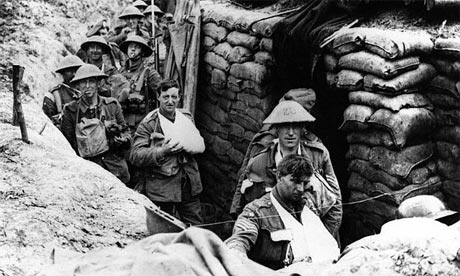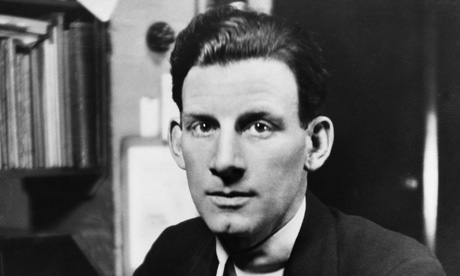90 years ....
- The Guardian, Monday November 10 2008

Troops moving around the trenches in the first world war. Photograph: Bettmann/Corbis
Inside an enemy trench, by Siegfried Sassoon
There wasn't much wire in front of quadrangle trench. I entered it at a strong point on the extreme left and found three officers sitting on the fire-step with hunched shoulders and glum unenterprising faces. Two others had gone away wounded. I was told that Edmunds, the battalion observation officer, had gone down to explain the situation to Kinjack; we were in touch with the Northumberland Fusiliers on our left. Nevertheless I felt that there must be something to be done.
Exploring to the right I found young Fernby, whose demeanour was a contrast to the apathetic trio in the sand-bagged strong-point. Fernby had only been out from England for a few weeks but he appeared quite at home in his new surroundings. His face showed that he was exulting in the fact that he didn't feel afraid. He told me that no one knew what had happened on our right; the Royal Irish were believed to have failed.
We went along the trench which was less than waist deep. The Germans had evidently been digging when we attacked, and had left their packs and other equipment ranged along the reverse edge of the trench. I stared about me; the smoke-drifted twilight was alive with intense movement, and there was a wild strangeness in the scene which somehow excited me. Our men seemed a bit out of hand and I couldn't see any of the responsible NCOs; some of the troops were firing excitedly at the wood; others were rummaging in the German packs. Fernby said that we were being sniped from the trees on both sides.
Mametz Wood was a menacing wall of gloom, and now an outburst of rapid thudding explosions began from that direction. There was a sap [a narrow communication trench] from the quadrangle to the wood, and along this the Germans were bombing. In all this confusion I formed the obvious notion that we ought to be deepening the trench. Daylight would be on us at once, and we were along a slope exposed to enfilade fire from the wood. I told Fernby to make the men dig for all they were worth, and went to the right with Kendle. The Germans had left a lot of shovels, but we were making no use of them. Two tough-looking privates were disputing the ownership of a pair of field-glasses, so I pulled out my pistol and urged them, with ferocious objurations, to chuck all that fooling and dig.
I seemed to be getting pretty handy with my pistol, I thought, for the conditions in quadrangle trench were giving me a sort of angry impetus. In some places it was only a foot deep, and already men were lying wounded and killed by sniping. There were high-booted German bodies, too, and in the blear beginning of daylight they seemed as much the victims of a catastrophe as the men who had attacked them.
As I stepped over one of the Germans an impulse made me lift him up from the miserable ditch. Propped against the bank, his blond face was undisfigured, except by the mud which I wiped from his eyes and mouth with my coat sleeve. He'd evidently been killed while digging, for his tunic was knotted loosely about his shoulders. He didn't look to be more than 18. Hoisting him a little higher, I thought what a gentle face he had, and remembered that this was the first time I'd ever touched one of our enemies with my hands. Perhaps I had some dim sense of the futility which had put an end to this good-looking youth. Anyway I hadn't expected the battle of the Somme to be quite like this.
Kendle, who had been trying to do something for a badly wounded man, now rejoined me, and we continued, mostly on all fours, along the dwindling trench. We passed no one until we came to a bombing post - three serious-minded men who said that no one had been further than that yet. Being in an exploring frame of mind, I took a bag of bombs and crawled another 60 or 70 yards with Kendle close behind me. The trench became a shallow groove and ended where the ground overlooked a little valley along which there was a light railway line. We stared across at the wood. From the other side of the valley came an occasional rifle-shot, and a helmet bobbed up for a moment.
I felt adventurous and it seemed as if Kendle and I were having great fun together. "I'll just have a shot at him," he said, wriggling away from the crumbling bank which gave us cover. At this moment Fernby appeared with two men and a Lewis gun. Kendle was half kneeling against some broken ground; I remember seeing him push his tin hat back from his forehead and raise himself a few inches to take aim. After firing once he looked at us with a lively smile; a second later he fell sideways. A blotchy mark showed where the bullet had hit him just above the eyes.
• Extracted from Memoirs of an Infantry Officer, by Siegfried Sassoon (1930). Copyright © Siegfried Sassoon, by kind permission of the Estate of George Sassoon.
- The Guardian, Monday November 10 2008

Siegfried Sassoon. Photograph: Bettmann/Corbis
I knew a simple soldier boy
Who grinned at life in empty joy,
Slept soundly through the lonesome dark,
And whistled early with the lark.
In winter trenches, cowed and glum,
With crumps and lice and lack of rum,
He put a bullet through his brain.
No one spoke of him again.
You smug-faced crowds with kindling eye
Who cheer when soldier lads march by,
Sneak home and pray you'll never know
The hell where youth and laughter go.

/https%3A%2F%2Fstorage.canalblog.com%2F33%2F16%2F508287%2F95344135_o.jpg)
/https%3A%2F%2Fstorage.canalblog.com%2F52%2F26%2F508287%2F95342137_o.jpg)
/https%3A%2F%2Fstorage.canalblog.com%2F42%2F99%2F508287%2F95342518_o.jpg)
/https%3A%2F%2Fstorage.canalblog.com%2F97%2F52%2F508287%2F55786848_o.jpg)
/https%3A%2F%2Fstorage.canalblog.com%2F33%2F68%2F508287%2F55786597_o.jpg)
/https%3A%2F%2Fstorage.canalblog.com%2F40%2F91%2F508287%2F98712362_o.jpg)
/https%3A%2F%2Fstorage.canalblog.com%2F38%2F76%2F508287%2F83379594_o.jpg)
/https%3A%2F%2Fstorage.canalblog.com%2F06%2F96%2F508287%2F83377251_o.jpg)
/https%3A%2F%2Fstorage.canalblog.com%2F92%2F69%2F508287%2F69301410_o.jpg)